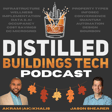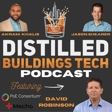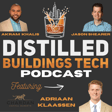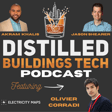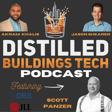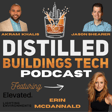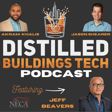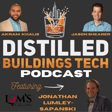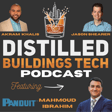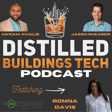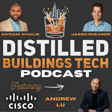Become a Creator today!Start creating today - Share your story with the world!
Start for free
00:00:00
00:00:01

Grappa, Neural Networks & Smarter Buildings with Giovanni Frezza
🧊 Overview:
In this episode of Distilled Building Tech, Jason and AK welcome Giovanni Frezza, Head of Smart Building at Molex. What starts with a tasting and history of grappa quickly evolves into a compelling discussion on the future of smart buildings, AI-driven optimization, IT/OT convergence, and the changing role of facilities management.
From physics labs in Rome to the forefront of digital infrastructure, Giovanni brings a unique, data-informed perspective to how we shape the built environment.
🍇 Grappa & Origins
- Giovanni shares his love for grappa, Italy’s post-wine distilled spirit.
- AK and Jason scramble to find their best substitutes.
- Discussion of varietals, aging, and cultural context.
🧪 From Physics to Facilities
- Giovanni’s early career in theoretical physics and neural networks (studied under Nobel laureate Giorgio Parisi).
- Transition to semiconductors and leading Molex’s Smart Building division.
🏢 The Smart Building Imperative
- Origin of Molex’s CoreSync platform and early collaboration with Cisco.
- Four core value drivers:
Energy efficiency & carbon neutrality
Predictive maintenance
Occupant wellness & comfort
Data-driven optimization
🤖 AI & Automation in the Built World
- LLMs help simplify complex building systems for FMs and stakeholders.
- Edge ML enables behavior modeling and real-time insights.
- Comparison to autonomous vehicles—buildings are becoming adaptive, not just automated.
🧑💼 New Roles, New Realities
- The rise of the AI-native facility manager.
- Skills shift as experienced FMs retire and systems grow more complex.
- AI as a tool—not a replacement—for human decision-making.
🌐 IT/OT Convergence
- Why networked power (PoE) is key to infrastructure design.
- Successful projects require early collaboration between IT, OT, HR, and real estate.
- The future is unified racks, segmented networks—like the evolution from legacy telephony to VoIP.
🔗 Learn More:
- Visit molexcs.com to explore the CoreSync platform.
- Connect with Giovanni Frezza on LinkedIn.
🥃 Final Sip:
From aged spirits to adaptive systems, Giovanni reminds us that the smartest buildings are the ones designed for people, powered by data, and driven by purpose.
Transcript
Introduction to the Podcast
00:00:20
Speaker
Welcome to the Distilled Buildings Technology Podcast. Where smart buildings are shaken, stirred, and data-driven. I'm your host, Jason Scheer. I'm your host, AK. And today we have Gio from Molex. Welcome, Gio. Thanks for joining us.
What is Grappa?
00:00:35
Speaker
Thank you, Jason. Thank you, AK, for hosting me. It's a pleasure. I'm excited to be here. And as as with every episode, like we give our guests kind of like dealer's choice or bartender's choice for what ah ah what what drink we're going to have.
00:00:50
Speaker
And it wasn't it wasn't necessarily a surprise to me, like knowing Gio, knowing his you know background and culture that his ah his his drink or aperitif of aperitif of choice is ah is grappa.
00:01:04
Speaker
yeah So Tell us, you know, for for those that have never heard of grappa, don't, you know, um haven't been around like Italian culture. Tell us a little bit about ah about the the the drink.
00:01:18
Speaker
Yeah. yeah Yeah. um So grappa, just so let me start from the name. Yeah. It's so originated from the Latin words of grappulum, that means grape cluster.
00:01:33
Speaker
ah So as you can imagine, it is distilled from Pomerate, from leftover, from making wine.
00:01:44
Speaker
um And it is a drink that the first recipe is dated around middle age. 1400 AD and was a pison drink because it was made from leftover mainly for digestive.
00:02:04
Speaker
In the last, I would say 100, 150 years, it evolved into a sophisticated spirit, Italian spirit, very typical, very classical, typical you get that after dinner with maybe cake or gelato,
00:02:21
Speaker
ah with ice cream or with cheese, aged cheese.
Exploring Grappa Varieties and Production
00:02:26
Speaker
um So today, particularly, I brought a little selection, and most of the bottles are empty because these are four samples. And I've had this since a while. And once in a while, I go after linaripp a little bit.
00:02:43
Speaker
um So this particular one is a single type. ah So it means a single type of grape. Grape, yeah. type and I have different type here. I have Amarone, it's a type of grapes, Chardonnay, Brunello di Montalcino.
00:03:01
Speaker
And so the Grappa is made with the leftover distilled and this particular batch has been aged in oak barrel, the same oak barrel that has been used to age wine before, 14 to 12 to 18 months.
00:03:18
Speaker
twelve twenty month ah That's what I have today. And I, yeah. That's fun. Yeah. yeah Yeah, I was, I'm the one that did not know what Grappa was, and I apologize for that.
00:03:33
Speaker
When went to the store, I did ended finding Grappa. It was not hard. It was just, and I've never come across it. But the one I have is awesome, I guess.
00:03:44
Speaker
Yeah. Awesome. i did I did find that that you need a special glass to drink it. I brought the equivalent of that. Actually, know I'm using something like this, is more ah small little sip, typically. And so I brought a typical glass I use.
00:04:02
Speaker
but and Thanks for the warning. I would have probably poured... No, no, but it's great because it gives time to really smell it and to have the organo-lectic characteristics that are great in my opinion because I love wines and so that's a good yeah Jason what about you? um so i I tried to find grappa here locally in Jackson Mississippi and had no luck um but i did I did find two substitutes in my and my liquor cabinet one is another Italian liqueur not made from grapes but made from cherries Lexardo Maraschino liqueur
00:04:44
Speaker
um But I did, and I bought this bottle of Port, which is a you know, it's another distilled, um you know, a distilled grape ah ah liqueur or aperitif.
00:04:59
Speaker
So it's a 20-year port that was bottled in 2015. So it's a 30-year port. um So that's that's the closest that I have to Grappa. But Having, you know, traveled and worked with Italians before, you probably know ah Francisco on the on the Cisco team.
00:05:15
Speaker
um Anytime you go to dinner with frances Francisco at an Italian restaurant, like that's what you're having as an after dinner drink for sure. Yeah, yeah.
Grappa's Geographic Significance
00:05:26
Speaker
what So there specific, you know, grapes that, so are there are there specific you know grapes that you know, that make grappa or is, is, is there any restriction on white grapes, red grapes that can be made with any types of grapes?
00:05:42
Speaker
Any type of grape. Uh, and, and, and, and to be, uh, simple, great wine, like, uh, Barolo, Brunello, Montalcino, uh, Amarone, these are red.
00:05:58
Speaker
Uh, they have the grappa version, the grappa derivative. ah White wine also has as well. So Chardonnay and other. I like personally single type because I like the flavor of that type of grape and in aging in barrel. So this particular one I have this chardo is is aged 18 months into the barrel. You get this taste of vanilla and voody taste.
00:06:34
Speaker
yeah. I like it. It's somewhat so somewhat similar to like the wine side. Like you have, you do have like some blends and then you have like single, single grape. And then even, even on other spirits, right? Like you might have, especially like scotch, for example, like, you know, single, you know, single malt, single barrel type, type of, ah type of distills to where like all you taste is, you know, kind of like the purity from that one, that one grain or that one grape.
00:07:02
Speaker
Correct, but but you can do you can do ah grappa from mixed. makes said no And so it can be, ah there are great wine that are mixed grapes.
00:07:13
Speaker
You can get excellent grappa from that too. So people are experimenting a lot. It's becoming really active um market and spirit as typical Italian.
00:07:26
Speaker
these ah This distillation is done in small batches, typically. in copper and then when is mature you put into the barrel if you want to have aged uh uh the one that you have um that is purely distilled and not aged is typically transparent white the transparent clear um ah like what aka has chris christ crystal clear the one that you have absolutely yes um and you see that you
00:07:57
Speaker
You see that in a lot of other spirits too, like tequila, right? like like Blanco tequila is generally not aged, but then like Añejo and Raposado is darker because it's been aged in barrels. Correct.
00:08:08
Speaker
And it's served, Gio, it's served neat just the same way you're you're you're drinking it, right? No ice, just straight, like a port eight would be served. Personally, I like no ice straight.
00:08:19
Speaker
ah Now, if you travel in northern Italy and you go in Trentino, for example, in the mountains, These are typical typical drink that you drink, it's cold, it's up in the mountain.
00:08:31
Speaker
But there are also derivation that has maybe um oh aromatize with berries, for example. or And so you may have if some that has flavor with natural fruits.
00:08:52
Speaker
um for people that like. I personally like pure um ah and no ice, just room temperature after dinner.
00:09:04
Speaker
It's great. And yeah, I hope. Jason, I will i will i will i bring you little sample. Yep, yep, yep. We'll definitely have grapple next time we're together. And then I guess my last question on grapple is it is it is uniquely Italian, right? So like in order for it to be Grappa, like it must be produced in in Italy.
00:09:28
Speaker
Yes, as a DOP brand, like it is a denomination. Is that the name? Or is there is there other versions of Grappa that's that's produced elsewhere in the world?
00:09:40
Speaker
I guess, I guess if you distill leftover of grapes, yes, you you can make your own grappa. Yes. so So I don't know, nothing that is really popular or that I'm aware that is another product branded that is competing, coming with the same kind of, ah so it seems to remain pretty much in the Italian ah kind of tradition.
00:10:05
Speaker
no Yeah. yeah Got it. Excellent.
Gio's Journey and Career at Molex
00:10:10
Speaker
So Gio, tell us a little bit more about who's Gio, what's your career arc, how did you get into yeah where you are and what are you doing? okay oh ah you Okay.
00:10:22
Speaker
So as you can hear from my accent and my selection, I'm Italian. well I moved in the U.S. in 2008. At the time, was... the time i was um um working for a semiconductor company, global company semiconductor, following the industrial perimeter, a large variety of product.
00:10:47
Speaker
And I came to develop ah or really lead the industrial business unit in North American market. And so is Gio. I'm ah ah born in Southeast of Italy equalling in a little town up on the mountain.
00:11:03
Speaker
not far from Naples and the Amalfi Coast. um not not Not a bad place. No, no, it's a great place. I miss it. I moved up in Rome when I was very young. my parents moved in Rome um and I graduated in physics ah in Rome from La Sapienza University. I've been very blessed.
00:11:28
Speaker
I studied with really top-notch scientists at the time. One was Giorgio Parisi that three years ago, he won the Nobel Prize for physics.
00:11:40
Speaker
He was my professor. And I studied neural network, oh mathematical model, statistical model to resolve neural network problems.
00:11:52
Speaker
After that, I was hoping to really go straight to work. um While in Italy a there was a change into the military service that was mandatory till the time it was becoming ah by will.
00:12:07
Speaker
I thought I was going to miss that when they called me for military service in Sardinia. So I went there and then I started working in semiconductor right away. moved to Milan and from Milan I moved to Chicago where I am um that's That's kind of geographical location for myself.
Smart Buildings and Digital Convergence
00:12:27
Speaker
ah I'm right now at Molex.
00:12:30
Speaker
I lead the smart building ah um business unit. ah And we started ah to develop a solution around 2015, 16, embracing an idea that um embracing an idea that digital convergence into the smart building ah was becoming not just a value to have but a must to follow in the sense that moving to connected building when you have things that talk to each other and so was a good was a good um
00:13:11
Speaker
field for Molex that has experience in various aspects and various field of the technology to put a solution together. And at the time we partnered with Cisco strongly with the initiative was called Digital Ceiling. had Digital Ceiling. yeah Yeah. Oh yeah. Long ago.
00:13:32
Speaker
ah And since then i continue to develop a ah platform a a solution that has physical layer and has also software to do smart building applications.
00:13:47
Speaker
Yeah. and for And for folks, I'm sure a lot of people in the industry know Molex. Molex is definitely a um like a household name in in technology, primarily around like you know connectors, cables, assemblies.
00:14:03
Speaker
But What you do with like with the CoreSync platform at Molex is pretty different than the rest of the company. Would you would you say so? Yeah, absolutely. one hundred percent
00:14:16
Speaker
if you guys and look around any electronic around you and you open it, you will find Molex connected. Absolutely. moles interconnectivity solution goes from data center to industrial, automotive, consumer, phone, any type of.
00:14:35
Speaker
And that remained the core business of the company. But there was a moment ah where Molex started to experiment and going on solution. So there was a big wave of solution development internally.
00:14:49
Speaker
I end up to be part of this initiative for Smart Building where we started from scratch to put some ideas together, building a solution and gradually we became ah player that has hopefully,
00:15:05
Speaker
um pioneeristically driving the market to adoption of digital technology. Yeah, and obviously the audience know that I lead one of the companies like MHT and and to the outside world, people think that, you know, CoreSync and MHT competes. We don't.
00:15:22
Speaker
Gio and I are family, right? So it is, we're trying to push the smart building initiative, which is obviously what's been the motivation for every end user. And a lot of it has been How does this technology, in your opinion, Gio, brings what the customer is asking for? right we we but Obviously, all of us collectively go after consumers that are looking for that technology.
00:15:43
Speaker
But in your opinion, what's the driver motivation for them? Why are they asking for this? but Thank you. Thank you for the question, AK. And I think in the moment we are living in today,
00:15:57
Speaker
data driven and digital transformation are the cornerstone to build really efficient and really ah productive business.
00:16:09
Speaker
um So when we started, I remember we were knocking the door clearly and say, yeah, you should you should be smartness in your building. You should put the connected ah technology.
00:16:23
Speaker
And Often the answer was, yes, ah do you have LED lighting solution and can we save the energy from LED lighting? Yeah. ah So I think we did kind of couple of turn around.
00:16:39
Speaker
um And today in the industry, I want to read it in this way. Companies that are already embracing digital transformation as a core part of their business future ah decided to make the corporate real estate as a part, as asset to leverage in that digital transformation.
00:17:01
Speaker
So of course, automation, efficiency, energy saving, these are still valid um driving point. And in the reason five years, I will say um regulation, um initiative on sustainability,
00:17:22
Speaker
are pushing the boundary and things that were possible before now become possible only if you have a connected platform that is going to cut down really energy.
00:17:36
Speaker
But the energy saving is not the only proposition. and in my opinion, the value-added proposition start to reside on this more abstract layer where you you want to have a system that is performing optimal, that is saving energy, is not wasting ah resources,
00:17:56
Speaker
ah but be able to ah get data out of the behaviors ah for the workforce in particular, but other segments that seem similar, and anticipated ah optimization challenge for the business is very important.
00:18:17
Speaker
So this data insight, I would call it, it becomes very important. Right now, I see there are three, four major drive, BI,
00:18:28
Speaker
um That technology like ours will help the industry to move forward. One is definitively energy saving and CO2 carbon neutrality.
00:18:39
Speaker
The second is how to optimize and minimize cost for operation and maintenance. So intelligent system able to have prescriptive and pre predictive maintenance are critical, are important, are um must well.
00:18:54
Speaker
The third one is about the comfort and the well-being of talents and humans. We spend, I was surprised by this data, we spend more than 90% of our life as human inside, in a building. I know. Believing or not, in some area, maybe less, in some area, a little bit more, but in average, 90%. So building remains crucial and acknowledging ah the quality of comfort, well-being, full resource.
00:19:28
Speaker
ah Before was a very soft say, like, yeah, you can boost productivity, right? Or how you quantify productivity, big challenge. ah Now there is more and more an absorbent notion that when you are good, when you feel good, when you like the environment, when you not only save time to find rooms and things like that, but when your hair is clean, when your temperature is optimal,
00:19:55
Speaker
ah You produce, you have a better life and you are a better employee. You contribute more. There is more productivity. So these are the kind of ah drive behind.
00:20:07
Speaker
ah And I think what happened in the last five years was turning around and all the promise around IoT and the value created by this insight now can become fruit.
00:20:22
Speaker
Before was always understood. difficult to extract. Now we have example of company that are now rolling out and with the maturity of AI at the level that we have today for our industry.
00:20:37
Speaker
ah So for example, machine learning, and I'm not just talking about chat box or big line language process,
00:20:49
Speaker
technology But machine learning has been optimized for year for two major projects problems. One is classification. The other is optimization. And the smart building industry will benefit from that. So it's a really it is ripe the market to adopt now with this layer of data analysis ah insight and data processing.
00:21:15
Speaker
data inside that can help company to make decision to optimize to the business overall.
The Role of AI in Smart Buildings
00:21:21
Speaker
Yeah, that was one when when you mentioned that, um you know, that your your master's degree is in theoretical physics and neural networks like that. I i i wrote that down.
00:21:31
Speaker
ah didn't know that about you, Gio. So I have to imagine that like this, this current cycle that we're in around excitement with ai um is great from your background. Like you're like, okay, it's finally here.
00:21:47
Speaker
so yeah yeah, absolutely. Yeah. yeah But like, how how do you, how do you see, and I'm a big believer, like you are like LLMs are great. Like they're going to help us increase, you know, increase like knowledge work, worker productivity, but the real, like the small models that are specific to outcomes and use cases, how do you see that evolving over the next couple of years? Like using LLMs as a,
00:22:13
Speaker
um as a kind of a springboard for building optimization? um In many ways, I would say there are multiple improvement points. And so I think we need to consider AI for what it is.
00:22:30
Speaker
And the state of today is funding you are mentioning. Yes, I was in University La Sapienza of Rome. There was ah a center of knowledge for neural network together with Berkeley University in so in another couple of centers across the globe.
00:22:50
Speaker
At the time, ah the calculator, the PC, the power processing, even the largest just PC we had in the ah basement of the physics department was not sufficient to resolve this large model. It was all about ah theoretical and mechanical statistic analysis. So I kind of graduated around those model, as I say, with Parisi, that was my professor, pioneeristically.
00:23:20
Speaker
And then I went into the industry, do semiconductor, material, application, others and and I wake up in 2020, kind of, where we to see like now a machine talking to you, understanding your language,
00:23:35
Speaker
putting together sensor, correcting your emails. Now everybody's experiencing that level of. So yeah seems to be a drastic, like it happened in a day, but no, it took 40 years to know really get there.
00:23:49
Speaker
Gio, how do you see it apply to to the building side? So to apply to the building, I think that when we talk about ai the scenario of AI is variegated.
00:24:02
Speaker
So, LLM models are great to do a job of interface with humans. So that use really simplify, if you want, ah the ability to interact with a robot, with a system, the machine.
00:24:21
Speaker
Our system ultimately, of course, when you deploy, you're commissioning, and it's orchestrating real-time control and all this stuff. It's a machine, it's a robot of working on a specific application.
00:24:32
Speaker
ah to interrogate the robot, or to interact with the robot in a simple way, ah we resolve a big problem that the industry, in my opinion, will start to see.
00:24:43
Speaker
ah Facility managers and that type of corporate of real estate leader are really seeing a big challenge. And the challenge is workforce is aging, people are retiring, they need to have new talent acquired, but the talent skillset,
00:25:02
Speaker
is changing and is different. And now if you need to have deep knowledge and ability to deep dive into system, because when you have a connected device, things talk over the network, need to have an environment that needs to, so it's not like the oversimplification is, ah yes, LED lighting, you can save energy, just replacing fluorescent.
00:25:25
Speaker
For connected device, you need an infrastructure. And so team that manage that, ah they will be under severe pressure to, and instead of need to learn individual system, the ability to have an interface that simplify, interrogate, and create a query for you to what is going on, that's a large amount of simplification saving operational costs.
00:25:50
Speaker
The other aspect, in my opinion, are more embedded into the product, so you can have AI at the edge, AI at the devices, because ultimately we are human.
00:26:01
Speaker
ah The machine and the model we built, they don't understand what AI might optimize. So you need to create model. And if you build products that are very use case driven, and that's, I think, our strength, and I can share the same, understanding what the use cases are driving, now the technology can help to really have abstracted layer and I can have a sensor today that is a motion sensor.
00:26:30
Speaker
It sends motion. um I translate that into an occupancy sensor, occupy, then occupy. Now, how we behave in the dynamic of the detection with machine learning model at that edge, I can start to abstract layer and create behavior indicator that can really help to optimize.
00:26:54
Speaker
Yeah. We can make a parallel between the autonomous vehicle. um The European Automotive Agency built a sort of a five stages ah classification of the vehicle from really manual, not even, ah to completely auto autonomous. And we know that that in this area, there is tons of vehicles
00:27:23
Speaker
innovation and development and about autonomous vehicles. Do I believe the industry will go through an autonomous building? With supervision, you still need humans to really interpret things and and do stuff.
00:27:39
Speaker
But I think a similar parallel, and we can go from bare bone building that has electrical wiring and you need to do everything manually to an automation ah to a more really full adaptable building that will adapt to the condition of the people and behavior and interact with humans.
00:27:58
Speaker
So I think that's what we are heading to. Yeah, the one thing I keyed on there, Gio, was ah you know when you're talking about these personas like facilities managers,
00:28:11
Speaker
Things are systems are not getting simpler, right? Like so systems are getting more complex. We're putting more systems into our buildings. These systems are being digitized and an FM. They are not data scientists, right? Like they do not know necessarily how to they may be an expert in one system like HVAC, but maybe they are not an expert in air quality or um or or lighting or shades or other other systems within the building.
00:28:39
Speaker
And LLMs can help, you know, abstract and simplify that for for the operator. I think that that's going to be ah massive advantage. mess Yeah, and I think there is going to be a time where but we're seeing even curriculum changes at the college, at the high school for a generation that graduates with a specific facility manager degree that is quite different than what we saw in the past, call it 100 plus years, right?
AI's Impact on Facility Management
00:29:06
Speaker
and Now your new facility manager might be smart building facility manager graduate than your typical just facility manager that we we all recognize that has its own skill set because the building already changed.
00:29:20
Speaker
Yeah, that's, that's interesting. Like we, I think a lot of people get nervous around, you know, AI and, you know, job replacement and all of that, but AK, like you, you hit it off. Like what is that, that new job title for an AI driven facility manager?
00:29:36
Speaker
Like that may be like a new job that we see come out of all of this. Yeah. I think you two both point a very important point. um observation.
00:29:49
Speaker
Indeed, okay you you can share and Jason, you as well, dealing with customer, right? How many interface we have. We have facility, that we have energy manager, then you start to have stakeholder, ah not just IT leader, but HR.
00:30:05
Speaker
ah People that want to know, yes, now that I don't need to know anything about the system. I work, I don't want to know anything, but can I extract the information that I need?
00:30:16
Speaker
and and and And so that is helping us to develop an overall 360 approach where the value proposition reside and reside in multiple topic in multiple bucket.
00:30:28
Speaker
ah is it's it's it's I think the AI, we will we will learn that it is a tool, it is not a replacement for human. Now, where you can add value is by ah the meaning and the um a structure you can make. So if something can be done by a machine, why you don't want to be done by a machine?
00:30:54
Speaker
And that these that is an aspect. But it is, my opinion, not by any mean close to replace um ah this job function. At the end,
00:31:05
Speaker
um there are critical functional facilities, like you have a customer for which you are responsible for. And um yes, the system, intelligent system, including AI embedded and machine learning can give tons of improvement, including predictive maintenance, preventive maintenance, things that can save company a big money.
00:31:33
Speaker
Well, and even even like like like life safety, like I think about life safety and like cant can we use systems and and, you know, AI, you know, ML models to be able to, for humans to make decisions faster to save lives.
00:31:49
Speaker
Like one great example I've i've heard of, Gio, is and this in the sensor space, like being able to do fall detection. Yeah. the and detecting that fall and dispatching, you know, someone from, you know, health and safety or whatever that, that team is like much quicker, like that, those minutes could, could, could have a significant impact on that, on that person's life. 100%.
00:32:16
Speaker
Yeah, agree. yeah agree
00:32:21
Speaker
Very cool. exciting so It's exciting moment. I think the the technology is, and this is an industry that doesn't have R&D typically, not our industry. We do. Technology provider and developer, yes.
00:32:35
Speaker
But building industry, they they they take a shot and put the technology in and learn from that. oh So there is also that part as a technology provider, it is in our kind of court to really gather what yes business-driven use case value and really develop and use technology for that that perspective.
00:33:04
Speaker
Ultimately, I think our um really effort and challenge and success reside in to digest the complexity that is behind phenomenal um situation and physics and whatever you need to detect or automation input and deliver a simple to use or a simple simple ah that is giving really digesting the complexity within the solution.
00:33:32
Speaker
And and and you you talk a little bit about like the kind of like the establishment, you know, building systems um and then more of like a technology led approach.
IT and OT Integration in Buildings
00:33:40
Speaker
think ah we can't have any of these conversations without talking about like ITOT convergence and how disruptive and challenging that is.
00:33:49
Speaker
Like, do you have do you have a customer example of where, you know, that, that, that, that challenge of, you know, IT kind of like pushing the envelope a little bit, like really won the customers, like the mind share of the customer from an outcome standpoint?
00:34:09
Speaker
I would say many, many examples. um And in the spectrum, ah I have seen company with IT or T completely separated. And I started to see company that has now hybrid function.
00:34:24
Speaker
um
00:34:26
Speaker
Obviously, yeah, these are connected technology. And when it is connected technology, we are talking about the network. And when we are talking about the network, that network is an infrastructure that support.
00:34:38
Speaker
um the building as an essential company that have embraced that convergence. ah I would say typically um have a much successful outcome for the project um and also make our life easier.
00:34:57
Speaker
Oh yeah, definitely. we we And we talk a lot about like in those, in those opportunities, you know Sometimes we're the ones, you know like as as manufacturers, like we're the ones that are bringing you know the real estate or the facilities or this you know the the space planning teams and IT together like at the at the same table.
00:35:21
Speaker
And I'd say maybe eight or nine times out of 10, those teams, they they might know of the guy that runs corporate real estate, but they don't really have a relationship with them.
00:35:32
Speaker
that's That's right. and And do we see that shift going from your perspective, Gino? Like you shared a few customers' success stories, right? If they converge and have an IT OT become successful, what what does that look like to an end user? Why should I take all my OT end product?
00:35:53
Speaker
You mentioned that it's connected, but what else can I do? Like I could just have a smart building with smart connected devices today. what are What are we doing different to give them that connectivity?
00:36:05
Speaker
So so so ah yeah, yeah. we Between you, Molex and MHT are pioneering since a while on the POE backbone
POE Infrastructure and Future Innovations
00:36:14
Speaker
infrastructure. So whatever it is a network and whatever we have the ability to use the network also to deliver power, that's a fantastic. So our key differentiation, I think, resides on the fact that we have um a a backbone ITOT ah network infrastructure that is optimized to deliver power and data.
00:36:37
Speaker
That's essentially the core. So we come we we came out with the platform that has that core element um that forced since the beginning ah the engagement with both sides of the house at the customer level, ITOT.
00:36:57
Speaker
um There is that element there. now still the preference customer today when they do they don't match they don't merge business IT with the network ah business OT at the building level even those are very similar networks ultimately but they have different scope different um um criticity etc e etc and so
00:37:28
Speaker
ah people now start to tend to design properly. So IT understands very well how to design a network. When it is applied to a smart building, that's not a big deal. It's very simple. So IT are really ready to support that part.
00:37:43
Speaker
They don't just don't want to be bothered by the application. like Yes. So just creating this... The application and the you know it t is generally already stretched very, very thin.
00:37:55
Speaker
So having like additional like resources like invested so that they can support those additional workflow workloads. Yeah, yeah. And with resource so they can't. they they can't And so typically what I have seen is most mature or successful design today as ah a parallel IT infrastructure network designed for operational technology, supported by typically by the IT staff, but then manage in term of application and use cases and the system that run on it ah by facility people.
00:38:35
Speaker
um And that is where the gap ah kind of a still going to. Yeah. yeah As i think I think we've all seen that in wiring closets, right? Where you'll have the IT t stack of network switches and the OT stack of network switches and then somewhere like they they converge at like an aggregation layer, but there's a physical separation today.
00:38:58
Speaker
Yeah. Yeah. And we, we'd see it more of a, I think it's, it's ownership, responsibility, and also risk management. ah We, so we think that in in the very near term, it's going to become one rack and you just segment it through the network.
00:39:14
Speaker
And that's what we hope that, that the intelligent building and the smart building looks like in the future, because you don't need to have two separations of both. it'll It'll get there. same i mean, like we people get tired of hearing about the you know the example of you know telephony, right?
00:39:31
Speaker
Once upon a time, you know telephony was managed by the facilities team, and they had their own separate closets. And now, like the voice network and the data network, they're on shared infrastructure.
00:39:43
Speaker
Same thing of video. And i think I think some of those other OT technologies, eventually, we'll we'll we'll get to that same point.
00:39:56
Speaker
Excellent. Well, Gio, how do people ah find out more about Molex and about CoreSync if they're interested in learning more, like maybe going down like this path of PoE and IP-enabled lighting and sensor technology?
Conclusion and Farewell
00:40:15
Speaker
ah So they can start from Molex website. to We have a website that is molexcs.com. CS stands for Connected Enterprise Solution.
00:40:26
Speaker
And there you find a coursing platform as the offering with all the getting contact with the Molex sales rep. Definitely we are a team ah very agile and very engaged to being contact with customer and talking and understanding what they are trying to do.
00:40:51
Speaker
Our go-to market is typical through value of the reseller and system integrators. So even through our system integrator channel, or if you are interested to become a system integrator certified for Molex, we will be happy to engage many.
00:41:09
Speaker
ah And um that that would be the best the best the best route. um and If it is just for consultation or getting information about product and technology or learning more, getting in contact with us.
00:41:27
Speaker
um And I am on LinkedIn. i am So people can reach out to me. I'm very happy to to engage in meaningful conversation on smart building, digital building initiatives.
00:41:41
Speaker
Excellent. Awesome. Well, Gio, it's been a pleasure. Really appreciate the time. and And as usual, like, subscribe, reach out to us for, uh, anything we need, but it was a pleasure to have you. Definitely. It's a lot of, it's lot of information.
00:41:56
Speaker
and did not know the neural network part about you. Yeah. this guy I was telling AK in the background, like that i this kind this conversation is not what I expected, but it like exceeded what I expected. Just thinking about how we integrate, um you know, AI and neural networks, like into, into, into smart buildings. So it's an awesome surprise to you. appreciate it. ah And yes, thank you for having me.
